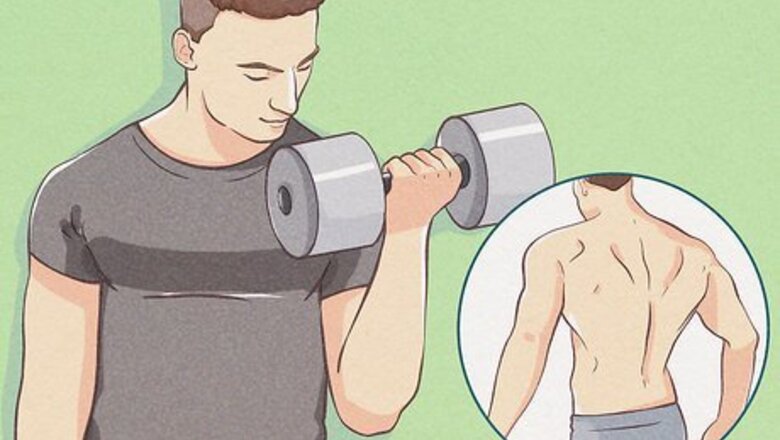
views
X
Research source
By building your back muscles with weights and enhancing the muscle growth with dietary choices, you can get a wider back.
Building Your Lats
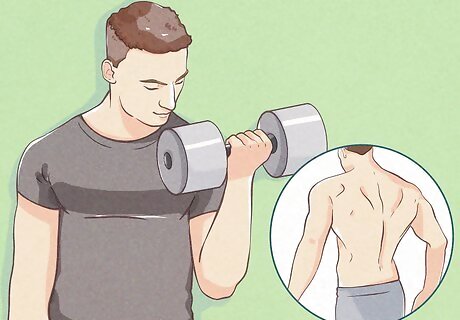
Develop a lifting program. It’s easy enough to go to a gym and just start pounding the weights. Since you have a specific goal—making your back wider—it’s a good idea to come up with a lifting program that will help you develop those muscles in the best way. You can develop your program either on your own or meet with a certified personal trainer, who may suggest different and more effective exercises for you. Consider how often you want to lift. You should train each muscle group at least twice a week to get the most muscle gains. Add a third workout to maximize your gains. Remember that it’s important between lifting sessions to rest, which allows your body to recover and build muscle. Incorporate exercises that target your larger and smaller back muscles to get the most gains in wideness and definition. This includes using your entire range of motion through different exercises. Choose seven to eight exercises that target your back muscles. Do two sets and vary the number of repetitions every few weeks to get the best gains in power, size, strength, and endurance. You can also consider doing one-armed versions of exercises to maximize strength. Make sure to build in a rest period of 45 – 60 seconds between sets.

Choose a combination of back exercises. When someone thinks of a “wide back,” the person generally means having wide latissimus dorsi, or lats. Your lats are the broadest muscles in your back and give it that "V" shape. Choose a combination of three to four of the following exercises that target and develop the strength of your lats. Pull yourself up. Pulling up your body weight is one of the most effective — and difficult — ways to build your lats. You can do a variety of different grips and variations of pull ups to build your lat strength. Place your hands on a bar using a narrow or wide grip. Once you’re hanging securely, engage your abs and pull up your entire body until your chin is over the bar. Do easier alternatives if you don’t have the strength. For example, you could have a box under your feet and jump up until your chin is over the bar. Then let yourself return to starting position. Do the alternative jumping pull up until you have the strength to do regular pull ups.
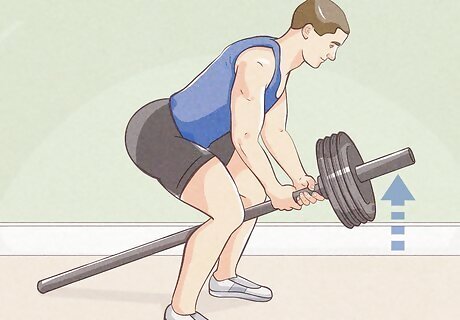
Do a bent-over row with a long-bar. The row is a weightlifting exercise that should not be confused with rowing on a machine like an erg. Instead, you will be lifting a long-bar while in a bent-over position. Find a long-bar — the kind you may see bodybuilders using — that weighs 30 – 45 pounds. Put some extra weight on one end if you are able or build up your strength 5 lbs. at a time. Begin with the bar in your hands, palms facing toward you. Bend your knees slightly and bend forward at your hips, keeping your back straight. Allow your arms to hang straight down, but don't lock your elbows. This is the starting position. Breathe out and use your forearms to lift the long-bar toward you. Keep your elbows in and your torso stable. Pause and contract your back muscles. Slowly lower your arms back to starting position and continue pulling up the weighted bar until you are finished with your allotted reps. Make sure to keep your shoulder blades down your back so that you target your lats. In some cases, pre-contracting your lats may help you more effectively engage and target this muscle group.
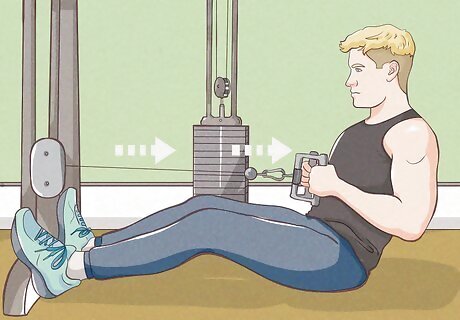
Sit down for cable rows. Another type of row that you can do to target your lats is the seated cable row. If the long-bar is too heavy for you or you simply want a different type of rowing exercise, try cable rows. Find a cable machine at your gym. You can use a variety of different bars and grips for seated cable rows including narrow grip "y" shaped handles, straight handles, rope handles, "W" shaped bars, and straight bars. Add a weight that you can lift comfortably but still challenges you. Sit on the seat with your legs and arms gently bent. Keep your back straight and abs engaged. Now pull the weighted cable towards you until your bent elbows are beside your ribs. Avoid pulling the cable too quickly towards you or you won’t get at your lats most effectively. Slowly release the handle back to starting position, which will help really build muscle. Continue your reps until you’re done.
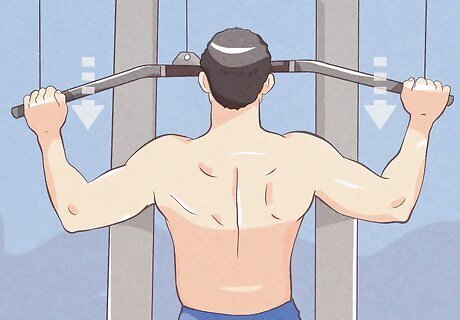
Pull down weight with your arms. Like pull ups, pull downs can also be an effective way to target your lats. Unlike pull ups, you use a weighted bar on a cable machine. Choose seated pull downs or standing pull downs. You can do both on a cable machine, but may need to use a different weight amount. Sit down in the same position for cable rows. Make sure the bar is above your head and grip it with your palms facing away from you in an overhand grip. Square up your shoulders and engage the muscles between your shoulder blades to help prevent injury. Contract your lats and pull down the bar, aiming the center of the bar at your sternum. If you can't pull the bar that low, don't worry — drop some of the weight and build up your range of motion over time. Release the weight to starting position and continue until you’ve finished your reps. Stand facing the cable machine with the bar set just below shoulder-height. Place your hands on top of the bar handle and retract your shoulder blades. You will use much less weight when doing this exercise. Push down the bar, keeping the arms fully extended forward with only a slight bend in the elbow, until the bar has gently touched your thighs. Slowly control the release of the weight as you return to the starting position and finish your reps. It is very important that you pull your shoulder blades back and down before and during the exercise. This allows you to access the lats.
Developing Your Deltoids
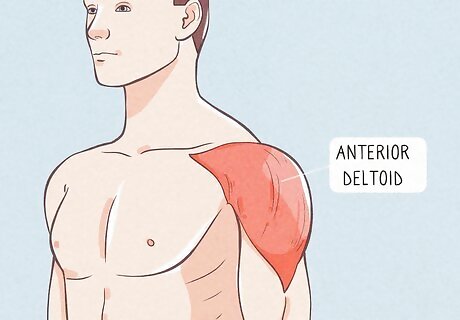
Hit your deltoids. Developing your shoulder muscles, or deltoids, is also key to getting a wider back. You want to make sure to build muscles along the three heads of the deltoids—the anterior, medial, and posterior—along with your rotator cuff. Doing shoulder work can help maximize your strength gains and make you look wider. Just as with your lats, incorporate three to four of the following exercises to build your deltoids.
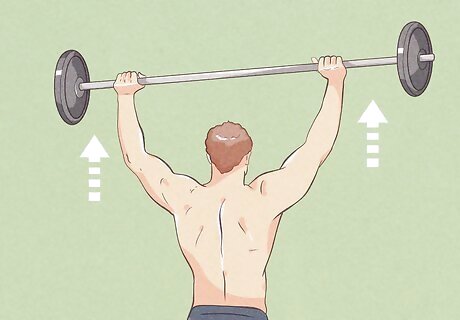
Do an overhead shoulder press. The overhead shoulder press is one of the most effective ways to build up your shoulders. You want to lift a bar or set of dumbbells directly above your head. Get a weighted bar or a set of dumbbells. Make sure the weight is comfortable but still challenging for you. Grip either the bar or dumbbells so they are slightly wider than your shoulders. Engage your abs and stand upright as you press the weight directly upward until your arms are straight. Return the weight to the original position and finish your remaining reps. Start with a light, easy weight. As you build up strength, increase the weight so that completing 10 repetitions is challenging.
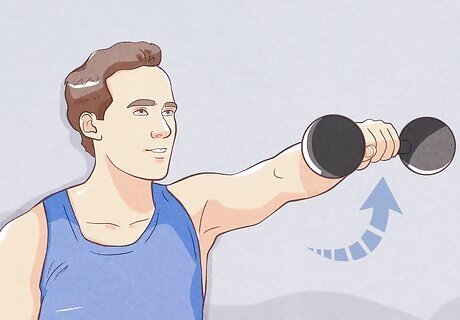
Raise dumbbells or kettlebells laterally. Lateral raises, which require you to lift weight upward with your palms facing the floor, are a great way to hit all three heads of your deltoid muscle. You can choose to lift dumbbells or kettlebells based on your preference. You may find that kettlebells are easier to grasp than dumbbells as you get stronger. Hold your dumbbell or kettlebell in a natural position with your palms facing inward. Using your shoulder muscles, raise the weight upward to the height of your shoulder. Your palms should face the floor while you lift. Consider alternating arms to give each a rest in between reps.
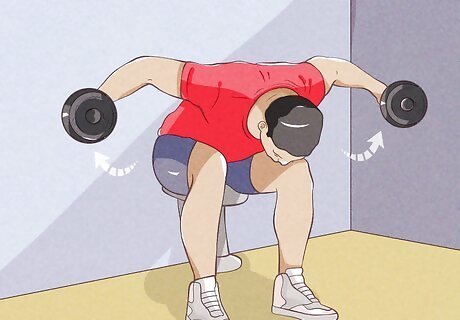
Fly some weight from a reverse position. Many people often forget the posterior head of the deltoid, which connects into the back muscle. Doing reverse flys can more effectively define your wider back and the connection between your lats and deltoids. Sit and bend over your belly or use an incline bench. Then raise your arms outwards in a Superman motion. Lift the weight until your arms are at the same height as your back and then return to starting position. Be aware that this part of your shoulders may not be as strong as the others. Don’t be surprised if you lift a lot less weight when you do reverse flys than with other exercises.
Developing the Rest of Your Back Muscles
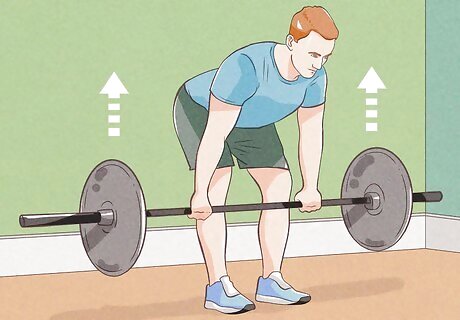
Fill out the rest of your back. Width may be your main goal, but it’s also important to train the rest of your back muscles to get an enviable V-shape and ensure that your muscles are properly balanced so that you don’t injure yourself. Be aware that many of the lat and deltoid exercises will also hit the lower and middle back muscles as a secondary effect, but you should do one to two exercises that also target these groups. Choose any of the following exercises to fill out your back muscles: Back extensions Pendulum exercises Deadlifts Cable face pulls[
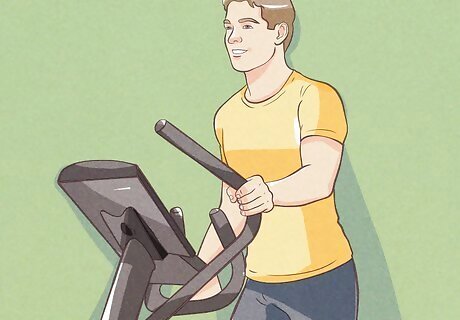
Add some muscle-building cardio. Part of showing off your wider back is also burning fat and being lean. Building muscle will help you burn fat effectively, but adding a bit of cardio to your workouts can help you get even leaner. Choose to do cardio that helps builds muscle in addition to burning fat and calories. Stick to two to four short cardio sessions of 20 – 30 minutes every week. While a little bit of cardio is good, too much can actually hinder your weight lifting gains. Do cardio exercises that can also help widen your back. Some examples of this are: swimming, rowing, using an elliptical, kayaking or paddleboarding, cross-country skiing, and windsurfing. Build in high-intensity intervals to get the most of your cardio session. For example, do one minute at a hard pace followed by one minute at an easier pace.
Enhancing Muscle Growth in Your Back through Lifestyle
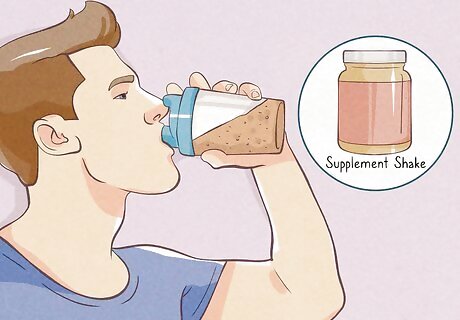
Drink a supplement shake. Exercise increases blood flow to your working muscles and having a shake with amino acids and carbohydrates may help you build muscle. Drink a whey-protein shake 30 – 60 minutes before your workout to boost the results of your weight lifting sessions. Buy your shake mix at health food and nutrition retailers. Read product labels to find a shake mix that has a healthy blend of amino acids and carbohydrates. You could get, for example, a ratio of 6 grams protein to 35 grams carbohydrates. Eat a turkey sandwich with a slice of American cheese on whole wheat bread if you can’t stomach a shake. This alternative may have the same effect.
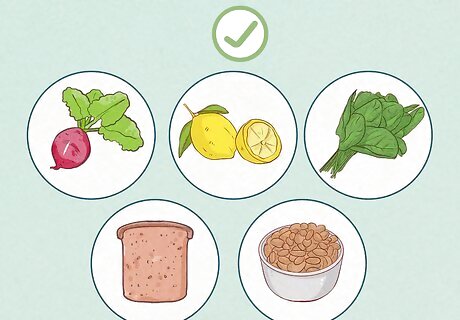
Eat five to six small healthy meals daily. Having five to six small meals every day filled with nutritious foods can maintain your health. It can also help build muscles, especially if you eat a healthy snack like a cup of cottage cheese after a workout. Incorporate different choices from each of the five food groups — fruits, vegetables, whole wheat, protein, and dairy — to ensure you are getting the proper nutrition to fuel your workouts and build muscle. Consider adding extras of the following foods to help you build muscle mass and gain healthy weight: Beets Brown rice Oranges Cantaloupe Cottage cheese Quinoa Spinach Apples Sprouted whole grain bread Wheat germ Chickpeas Lentils Beans Flaxseed
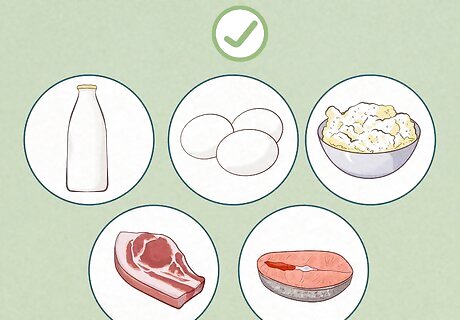
Increase your protein intake. Protein helps to build muscles. Getting enough protein from whole, lean food sources helps increase your muscle mass. Choose lean meats such as chicken and dairy products like Greek yogurt to get more protein. Some other good sources of protein you might want to incorporate into your diet are: Organic milk Eggs Cottage cheese Grass-fed lean beef Nuts and nut butters Rotisserie Chicken Bison Seafood such as scallops Fish such as tuna, salmon, and sardines
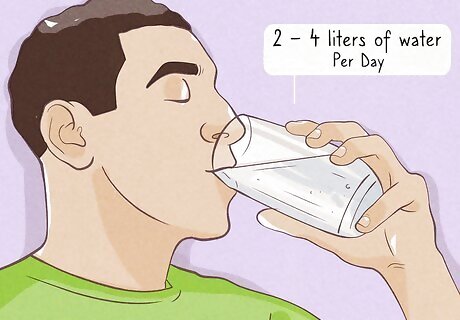
Hydrate your body. Just as a healthy diet is important to help your body recover and build muscle, so is getting enough water to drink. It also improves your performance when you train. Aim to get 2 – 4 liters of water per day based on how active you are. Remember that eating lots of nutritious fruits and vegetables will also increase your daily water intake. Make sure you are properly hydrated before a workout to optimize your performance. Keep a water bottle handy during workouts to ensure you’re replacing lost fluids.
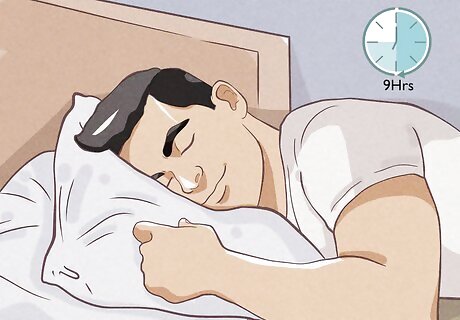
Get enough rest. Every person needs sufficient rest to help him or her recover from the day’s activities. This is especially true if you’re training hard. Getting enough sleep every night helps your muscles recover and grow. In fact, not getting enough rest may sabotage all of your training and diet efforts to get a wider back. Get seven to nine hours of sleep each night. If you are tired or feel fatigued, allow yourself a 30 minute nap to relax and refresh.















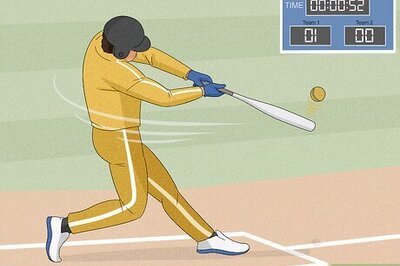

Comments
0 comment